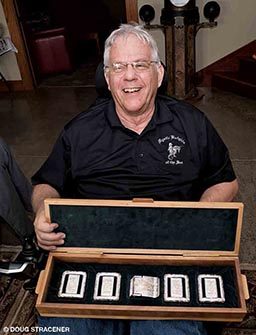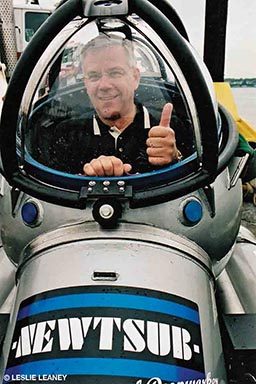Hometown: Minneapolis, Minnesota
Years Diving: 50
Favorite Dive Destination: Almost anywhere in Indonesia, but I love Wakatobi in particular
Why I’m a DAN® Member: I am a DAN member due to my strong belief in diving safety. Nothing like having to retrieve a dead diver to make you believe in the culture of dive safety.
Lee Selisky is famously known as the “lead king.” The success of his Sea Pearls dive weight business is rooted in his deep love for the scuba lifestyle. Despite his half-century engagement with diving, he didn’t begin there. Selisky started his manufacturing career at Honeywell, which taught him about plastics molding and die-casting. After two decades of working for others, including a night job at a grocery warehouse while running his business during the day, he finally committed to going it alone.
The dive bug bit him early, especially wreck diving in nearby Lake Superior. He took multiple dive courses from the National Association of Underwater Instructors (NAUI) when the discipline was still very rugged. As Selisky describes it, “In my certification class, we’d all go down in the pool as a group, and we couldn’t come up until the last tank was empty. If one person ran out of air, he had to buddy breathe with another until no one had any air left. There could be a dozen of us breathing off one tank. Now you could be an instructor with everything we had to do to be a basic scuba diver.” In the end he was well prepared for the deep, cold wreck dives he would do almost every weekend in the summer through the mid-1970s and ’80s. The big change in his life came by wanting something he couldn’t have: two 9-pound weights.

Selisky wanted 18 pounds of weight for his coldwater drysuit, but he wanted it configured as a pair of 9-pound weights for balance. Nobody made 9-pound weights, so for $40 he bought a mold to cast his own. The company accidentally sold him a mold for a 6-pound weight and did not accept returns, so in his frugal nature he poured a few weights, thinking he might be able to sell them. He finished the weights as perfectly as he could and went to a nearby dive retailer. In no time he was selling them 4 tons of weights per year. The principle that guided Selisky’s business philosophy was “underpromise and overdeliver.”
They were known as “Selisky weights” until one dive shop displayed them in a giant clam shell. To Selisky’s imagination, they looked like sea pearls, so S. Lee Selisky, Inc. became Sea Pearls, Inc. It wasn’t a quick and easy path to riches, however; after 10 years of hard work and living off his wife’s income, he took his first paycheck.
Sea Pearls wasn’t the only weight manufacturer, but Selisky predicted that the first to manufacture by die-cast would prevail. Each weight mold cost $8,000, and molten lead was injected at 3,000 psi. He had three machines, each capable of manufacturing 600 pounds of dive weights per hour. Dive weights were no longer a cottage business, and Sea Pearls pioneered large-scale manufacturing of them.
By the mid-1980s, buoyancy compensators (BCs) in bright green, yellow and pink were all the rage, yet lead weights were still the dull color of, well, lead. Through trial and error (emphasis on the “error”), Selisky managed to coat weights in vinyl, which could be colored. By 1981 he was exhibiting Sea Pearls weights at the Diving Equipment Manufacturers Association — later renamed the Diving Equipment and Marketing Association (DEMA) — show, growing the business to $6.5 million in revenue with a network of 1,300 dive retailers across the country. When he discovered that shipping the weights to Singapore was less expensive than shipping them to Florida, the global market opened to him.

With more time and money, he could afford to work on altruistic projects to benefit the dive industry that he felt had been so good to him. He began to attend DEMA member meetings and by 1992 was elected to the board of directors. In 1994 there was enough dysfunction in the organization that, as Selisky recalls, “They asked that whoever wanted to be DEMA president to take one step forward. Everyone else took one step back. Before I knew it, I was president!”

During his six years on the DEMA board, three as president, there were several issues of great consequence. The DEMA trade show was the primary asset, and it needed to be nurtured. The use of nitrox was a big fight, but Selisky was an early and vocal proponent of what some then considered to be a “devil’s gas.” A former president of the Historical Diving Society, Selisky is also an avid collector of valuable dive memorabilia. His accumulation of diving helmets is one of the largest private collections in the world.
Selisky’s greatest contribution was to the board of directors of Divers Alert Network (DAN), for which he was honored with the DAN Lifetime Achievement Award at the 2017 DEMA Show. DAN’s CEO Bill Ziefle reflected, “Lee Selisky has devoted his life to diving. Though most people know him as the founder and CEO of Sea Pearls, which he sold in 2007, Lee is also well known for his active service on many industry boards, including DAN’s, over the years. His thoughtful counsel has helped guide this industry for more than 40 years.”
Selisky has earned relaxation. He and his wife of 51 years, Lorie, have one daughter and two granddaughters. Family is the most important thing to him, and all was wonderful — until it wasn’t. In January 2017, Selisky was diagnosed with amyotrophic lateral sclerosis (ALS), also known as Lou Gehrig’s disease, a progressive neurodegenerative disease that primarily involves the nerve cells responsible for controlling muscle movement. Weakness or failure of the breathing muscles is what makes ALS fatal.
Selisky has had the time and introspection to ponder his passing. “I feel I’m still upbeat 99 percent of the time, but when I do have to talk about dying, I say I had a great life, it’s just shorter than I had in mind,” he said. “Everything was going along perfectly until the ALS hit. So yeah, it sucks, but I’ll keep living my life to the fullest to the bitter end. People say they’ve never seen someone with a more positive attitude than I do. But really, what should I do? Crawl in a hole and feel sorry for myself? No one can make it better, so I want to enjoy life as much as I can.
“I treasure my involvement with the DAN board and my friends in the dive industry. My work and my family make me feel my time on Earth has been worthwhile.”
Explore More
| © Alert Diver — Q2 2018 |